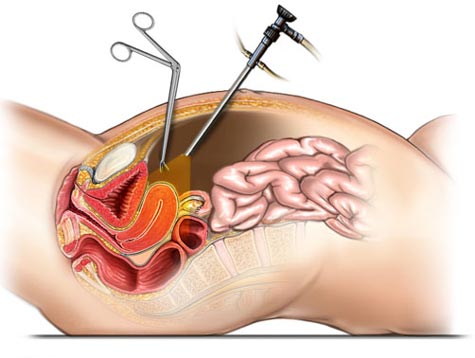A hysterectomy is a surgical procedure to remove the uterus. It can be used to treat a variety of chronic pain conditions, cancer types, and infections.
What is the indication for laparoscopic hysterectomy
- Uterine fibroids
- Endometriosis
- Uterine bleeding that isn’t normal
- Endometrial hyperplasia
- Uterine cancer .
- Uncontrollable postpartum bleeding

What are the different types of hysterectomy?
- A partial hysterectomy is a surgical procedure that removes a portion of the uterus. They may be able to keep their cervix intact.
- Total hysterectomy: The doctor removes the entire uterus, including the cervix, in this procedure.
- Salpingo-Oophorectomy and Hysterectomy: The uterus, as well as one or both ovaries and fallopian tubes, are removed during this surgery.
Procedure
Laparoscopic hysterectomy removes the uterus through small incisions rather than a large cut in the abdominal cavity.
The procedure is carried out under general anesthesia, with small incisions of around 5 mm on the abdomen. The abdomen is now filled with carbon dioxide gas, and a thin, lighted telescope (also known as a laparoscope) is introduced through a small incision. The camera-equipped laparoscope allows the surgeon to view the ovaries, fallopian tubes, and uterus on the large monitor attached to the laparoscope. Other instruments are inserted into the abdominal cavity through additional incisions. The real procedure now begins as the surgeon secures and divides the uterine blood vessels before freeing it (the uterus) from the surrounding supports, including the vagina to which it is attached. Before removing the uterus from the pelvis, other pathologies are examined and corrected. After the uterus is removed, the vagina is closed, carbon dioxide gas is released, and the skin incisions are closed.
What is the Recovery time?
Usually, you will be shifted to your room 8 hours after surgery. You’ll be able to eat soft foods once you get to your room, and you’ll be able to move around without assistance by the next day. If everything goes well, you can go home the next day. For a few days, you will be given antibiotics and analgesics. After two weeks, you can restore to light work. Sutures may need to be removed after a week.
Advantages of laparoscopic hysterectomy
- Pain will be lesser and hence a lesser amount of pain relieving medicines needs to be taken.
- In comparison to open surgery, the patient can resume normal activities soon.
- Small scar
- The recovery period following surgery is relatively short.
For these reasons, when such a need arises, laparoscopic hysterectomy is frequently preferred.
Schedule your appointment for Heavy vaginal bleeding with Dr. Deepika Doshi Lady gynecologist in Mumbai at Dhanvantri hospital.
MOST SEARCHED KEYWORD
Gynecologist in Krishna Nagar, Shanta Nagar, Borivali West | Gynecologist in Ekta Bhoomi Garden 3, Food Corporation of India Warehouse | Gynecologist in Khanderao Dongari, Borivali East | Gynecologist in Mig Colony, Borivali | Gynecologist in Sumer Nagar, Borivali West | Gynecologist in Hari Om Nagar, Borivali West | Gynecologist in Vivekanand Nagar, Borivali West | Gynecologist in Roshan Nagar, Borivali West | Gynecologist in Himmat Nagar, Borivali West | Gynecologist in Pai Nagar, Borivali West | Gynecologist in Ambawadi, Borivali | Gynecologist in Nehru Nagar, Daulat Nagar, Borivali | Gynecologist in Sukarwadi Borivali | Gynecologist in Chitrakoot, Kulupwadi Borivali | Gynecologist in IC Colony, Borivali West | Gynecologist in LIC Colony, Borivali West | Gynecologist in Gorai, Borivali West | Gynecologist in Eksar, Borivali West | Gynecologist in Maharastra Nagar, Borivali West | Gynecologist in Saibaba Nagar, Borivali West | Gynecologist in Yogi Nagar, Borivali West



